Genre: Sports Developer: Mirrorsoft Publisher: Mirrorsoft/Image Works & Virgin Int. Players: 1-2 Released: 1990
The Bitmap Brothers is somewhat legendary among the European home computer developers: Its games for the Atari and Amiga systems were fast and furious spectacles, combining frantic action with beautiful 16-bit graphics. After making a name for itself with the shmup Xenon, for its second outing the company came up with a critically acclaimed futuristic sports game. Speedball first and foremost impressed critics with its fast-paced gameplay and became a hit on its original release for the Atari ST and Amiga 500. So, the decision was made to port the game over to 8-bit systems as well. The C64 version also turned out very well – some reviewers even argued that the port might just be the better version – and eventually, publisher Image Works brought the game over as a PAL-exclusive release for the Master System.
There actually were two releases of the game for the European Market: One by Mirrorsoft/Image Works, and the other by Virgin Interactive. Both games are identical, save for different intro screen and a note in the credits. The reason behind that are a bit convoluted, but here’s the gist of it: In 1992, Mirrorsoft – the parent company behind Image Works – was bought out by Acclaim, which wasn’t interested in the Image Works library. When the latter ceased to exist as a result of the acquisition, Virgin, which had just decided to enter the games market in full swing, decided to pick up the rights and continue the distribution. Must have been worth it, no?
Speedball takes place in a small steel rink, about three screens in length. Two teams, with four field players and a goalie each, face off and try to score by throwing a steel ball, which is shot into the arena in a random direction, into the opposing goal. There are no fouls, so the player is encouraged to strike down the other team to his heart’s content. Basically, a game can be won through a combination of quick tackles, fast passes and a good aim at the goal.
That’s the short version, but there is a little more strategy to the game as well: Every once in a while, letters pop up in the arena. If you’re able to cross one of them, some kind of status effect comes into play for the next nine seconds, which can range from (s)lowing the opponent down to (f)reezing them in place or turning the ball into a (w)eapon that makes the other players fall over. Bumpers in the arena and teleporter gates in the side wall influence the direction the ball is taking if you hit them, so players have to keep that in mind during matches. There are a few different play rinks in fact; they look very similar, but they differ in the location of the bumpers.
Control-wise there is only one button; 1 and 2 do exactly the same. On offense, a quick button press results in a pass or a shot at the goal, on the defense you attack the opponent, trying to grab the ball from him. A long button press results in a high pass. If a player is directly underneath the arc the ball is travelling in, another prompt makes him jump and catch it. What’s also important is that you only directly control the field player closest to the goal, while the goalie can only be controlled indirectly, as he only follows the left and right motions of the teammate closest to him. This takes some getting used to, so be prepared to lose a few points because you couldn’t properly coordinate the movement of your defense and your goalkeeper.
The Master System offers two play modes: one player knockout and a two-player game. While the latter is simply a versus match between two human players, the former pitches you against 10 consecutively stronger opponents. You have to win in order to advance, a draw results in a rematch against the same opponent. Knockout mode is also where the collectible tokens come into play: If you pick up dots randomly appearing in the arena during gameplay, you can use them after the match for a certain range of effects. You can either improve your stats (skill, power and stamina), reduce the stats of your opponent (relatively pointless, to be honest) or bribe the referee to give you a head start in your next match! The home computer versions also had a league mode, but due to a complete lack of game saves, the Master System port scratched that one entirely.
High speed needs tight controls, and both were big draws of the game for the home computer crowd. However, this is where the Master System version drops the ball. Here, the game flows rather sluggish, moves jerkily, and slows down even more when there are more than three sprites on screen at the same time. It also suffers from loose controls, which are problematic if you make a scoring attempt with diagonal throws in particular. The hit detection also seems a bit off, particularly when it comes to the bumpers. If you stand too close to them when passing or shooting, the ball gets deflected, even though the player seemed to already stand behind them.
The Master System port also suffers in terms of presentation. What little music there is in the game is high pitched and very bleepy, a far cry from the adrenaline-pumping tunes of the original. During gameplay, there isn’t any music at all, but the sound effects of balls hitting walls or players crashing into another are very scratchy and lack any sort of impact. At least the graphics are decent, but with the low framerate on display they fail to impress.
It’s too bad that a game called Speedball, of all things, fails to get any momentum going. The original concept thrived, no… lived from its high pace and tight control scheme. Both are sadly absent in the Master System version. With loose controls, sluggish gameplay, and a weak sound design this port kills anything the original game had going for it. Speedball it ain’t… Dragbump would be a more appropriate name for it, and nobody wants to play something like that.
Discuss this review in our forum.

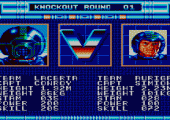
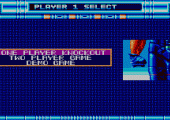
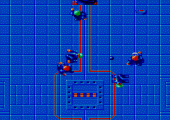
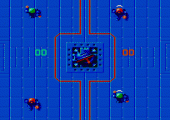
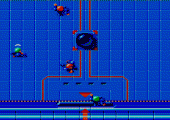
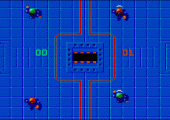
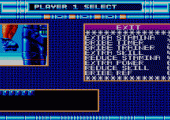
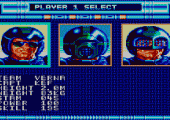

Recent Comments